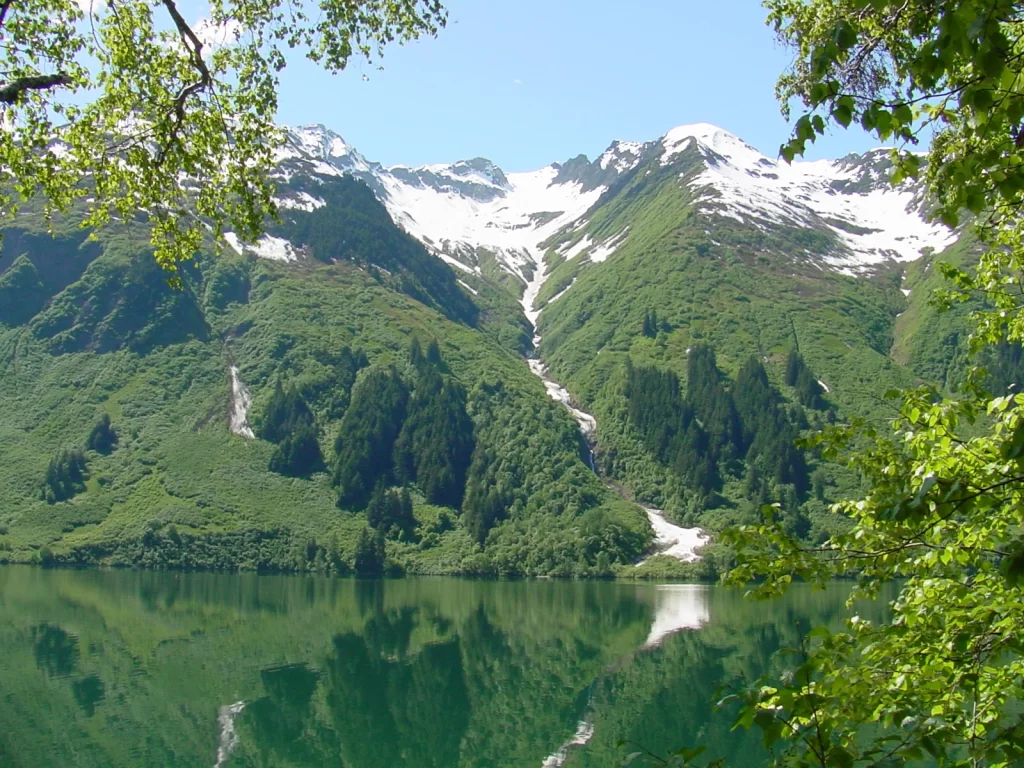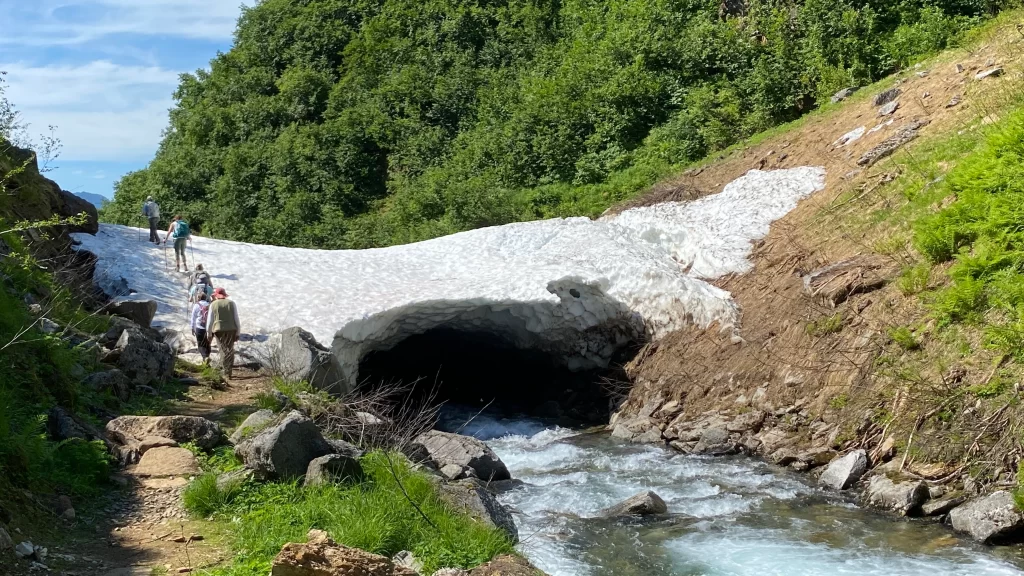July 2021 – We spent six glorious, tranquil days at our self-built efficiency cabin on the lake following the celebration of life gathering for our two friends. The cabin offers a type of peace and restoration for me that is unlike any other place I’ve found. Life scales back to its simplest tasks and necessities. Limited cell phone service contributes to a level of isolation and serenity that is difficult to achieve in much of the world these days. My mind can rest while contemplating the scenery and the forces that created it. I sat for hours on the deck, watching, listening, feeling the calm rhythm of life without obvious human intervention. The jagged, snow-covered peaks and glacier-filled bowls across the lake create an echo chamber for the persistent, low roar of the waterfall that cascades onto the opposite shore. The waterfall is white noise in the background as birds chirp and trill in the trees, and salmon and trout break the mirrored lake surface to grab insects. A light breeze rustles the leaves of birch and the boughs of Sitka spruce, while the glint of the sun flashes and sparkles on the rippled water. This, I imagine, is what heaven looks and feels like. I soaked it in for as long as possible, knowing as soon as we returned home, both Marty and I would resume our usual modern domestic life responsibilities, trying to keep a variety of plates spinning on an often wobbly spindle. I would also resume cardiac rehabilitation. The question still lingered in the back of my mind. Is my heart really okay?

My next cardiac rehab appointment followed the same pattern as the previous ones. An EKG monitored my heart while I walked on the treadmill. The heat in my chest rose within a few minutes of walking at my normal pace. I chose the emoticon that represented a 2 on the 0-to-10 pain scale. With more walking and a slight incline, it rose to a 3, then seemed to settle back to a 1. I tried to give the rehab specialist a precise description of my symptoms. When I completed the treadmill walk, we sat down and he showed me the report from the cardiologist in Idaho. “See,” he said, trying to mitigate my concern, “the angiogram report says that the rest of the vessels in your heart were wide open, and they opened the blocked ones with stents. And there was no damage to the heart muscle. You should not be having any pain. You should be fine.” His explanation of the chart made me think patients often questioned the success of their treatments. I could see what the report said, but it didn’t explain why I was still feeling chest heat and pain. I couldn’t deny that the substantive evidence pointed to a full repair of any issues in my heart, and I understood the rehab specialist’s message that I should not be having pain. Frustrated by the contradiction, I wondered if I might be overly-sensitive to any discomfort in my chest-maybe it was all in my head. It had been less than two months since my heart attack. Perhaps my expectation to be pain-free at this point was unreasonable. Perhaps if I trusted the two stents to hold those arteries open, my pain would go away.
With the reassurance that my heart should be fine, I hiked up to Salmon Creek Dam the next day with my hiking group. The trail has a steep uphill climb for about two-thirds of a mile at the beginning, but then levels out for a couple of miles before climbing again up the side of a steep ridge to get to the dam. I felt the familiar burn in my chest as I hiked the first uphill section. I took a tablet of my prescribed nitroglycerin to see if it made a difference in my chest heat. If the burn diminished, it didn’t last long, and by then I’d reached the flatter section of the trail. The pain subsided and allowed me to keep pace with the middle of the hiking pack while still conversing with my fellow hikers. When we reached the junction for the dam trail, some of the group turned back, while others opted to continue on. I argued silently with myself. Should I try it? Could I do it?
As the smaller group started up the dam trail, I needed to make my choice. I was uncertain if I’d be able to finish it, so I stayed at the back of the group to avoid the pressure to keep pace. Prior to my heart attack, I was often in the lead group of hikers, but now I was not sure I could keep up and didn’t want to block the way of faster hikers. The trail transformed into a series of stairs and obstacles to overcome with the use of handholds. I stopped regularly to let my heart rate come down, and though I felt some mild burning, it didn’t seem as pronounced as when I first started the hike. I arrived at the dam a short time after the others. Everyone sat on a wood platform near the water’s edge where we could enjoy the magnificent view of the peaks across the lake. We ate the snacks we packed and guzzled water before heading back down the trail. I had no difficulty hiking downhill. By the time I reached my car, I had hiked just over seven miles. I was tired, but not to the point of exhaustion. Completing the hike encouraged me and seemed to be proof that my heart was, in fact, repaired. In the succeeding weeks, I adapted to my “new normal” of some burning pain at the start of each hike that would resolve after about 15-20 minutes of walking, with or without the help of nitroglycerin. I hiked Sheep Creek, Granite Creek, and a variety of other trails of about 5 miles round trip. But I also noticed I still had occasional chest burning when I wasn’t doing anything, such as when I was sitting and inactive. I didn’t understand why, since I had been taking the acid-reducing medication that my doctor prescribed.

As I became more accepting of what had happened to me, I shared news of my heart attack with one of my close friends in Juneau and another dear friend who splits her time between Hawaii and Washington. Speaking about my experience in the past tense seemed to make it easier to talk about. It happened, and despite my not being fully recovered yet, I was working my way toward it. I spoke as a survivor, not as an active patient. I also entrusted one of the long-time hiking group members with my information. Someone needed to know, just in case something happened to me during a hike. Nitroglycerin was always in my pack, I reassured her, and I wouldn’t start a hike or would turn back if I was unsure of finishing. Her reaction was the same as others I’d told: shock and disbelief that I’d had a heart attack, because I appeared young, healthy, and strong.
Talking through my experience also helped my resolve to find a different general practitioner who might be a better fit for me. Although my current doctor seemed competent, her fast pace and demeanor often made me feel as though she wasn’t listening to me. In the past, I had required little specific attention, but now I needed assurance that my doctor was listening and hearing my concerns. My first meeting in August with the new doctor was a pleasant surprise. I didn’t feel rushed. She took the time to listen to my story. She was also concerned about the recurrent burning pain in my chest and didn’t blame it on acid reflux. Finally, I felt validated. The doctor prescribed a new medication to see if it might offer some long-acting pain relief: a half-tablet to start, then increasing as needed, with a re-evaluation of my progress in two weeks. She also wanted me to schedule a visit with a cardiologist at Virginia Mason in Seattle, the nearest option for this specialty care, as soon as possible. I scheduled a cardiology video appointment, the only alternative to flying to Seattle, since cardiologists stopped traveling to Juneau once a month when the pandemic began.
Two weeks later, I revisited my new doctor as planned. Despite repeated walks and hikes to test the new medication, it made no meaningful difference in my symptoms, even at the full dosage. The next steps, she said, would need to be guided by the cardiologist. That appointment was just a few days away. Meeting a doctor for the first time by video was an unfamiliar experience, but with COVID-19 still prevalent, it proved an efficient means to accomplish an initial evaluation. After we reviewed my history and treatment since having the heart attack, the cardiologist agreed I shouldn’t be having ongoing symptoms. She asked me to come to Seattle as soon as possible for an angiogram to determine what was happening in my heart. My appointment at Virginia Mason was just two days away.
After nearly three months of questioning and worrying over why I was still having pain, I was finally going to get some answers. As Marty and I boarded the early morning flight, I realized I was joining a segment of the Juneau population that flies to Seattle regularly to access medical care that is unavailable in Juneau. It made me feel old, but it also gave me hope. I was going to get the care I needed to get back to my former self. The next stage of my heart journey was beginning, but resolution would not come quickly or easily.

I am so happy that you are writing and posting again! There is so much more to your story that is going to be an inspiration to many.
Thank you, Cathy! I’m so grateful for the encouragement.